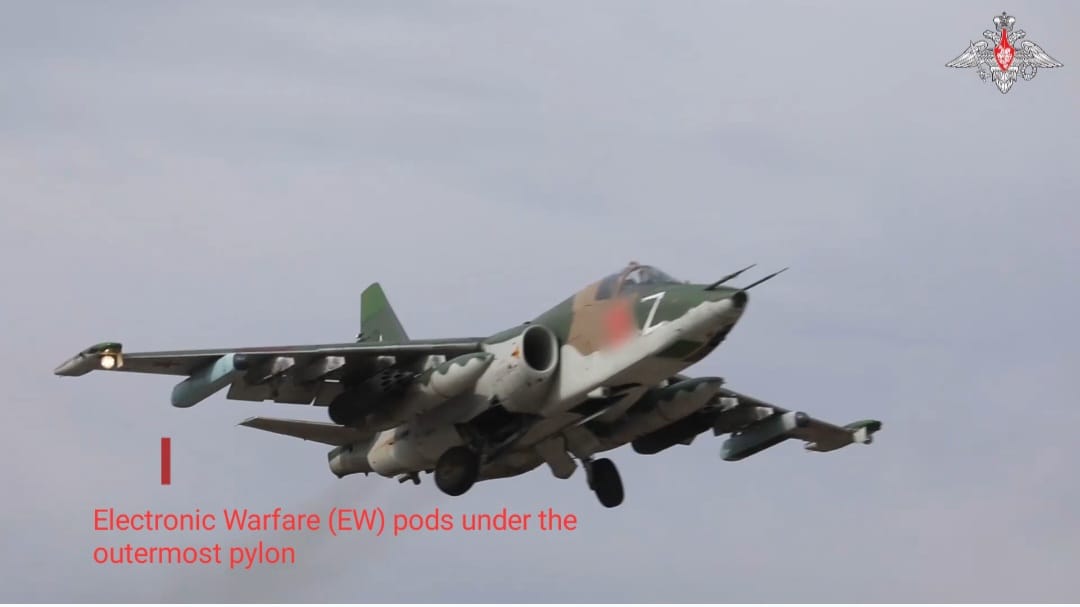Russia’s Sukhoi Su-25 Frogfoot ground attack aircraft are now flying with electronic warfare pods meant to disrupt tracking by Ukrainian air defense radars or even jam incoming surface-to-air missiles. The planes with the new capability are seen in a series of routine publicity materials released by the Russian Ministry of Defense (RuMoD).
Since the beginning of the war, the heavily armored Su-25 has been the mainstay of low-level rocket attacks on Ukrainian ground positions, flying missions in the various sectors from the northeast, east, and south almost every day.
The appearance of an EW-capable jet comes after the recent series of losses of its Su-34 Fullback fighter bombers and A-50U Airborne Warning and Control System (AWACS) aircraft.
RuMoD Videos & Possible Tactics
In the video released on March 23, the RuMoD described it as “ground-attack aircraft continuing to hit Armed Forces of Ukraine (AFU) units in the Severodonetsk direction.”
During a “combat sortie, Su-25 ground-attack aircraft struck camouflaged enemy hardware and manpower with unguided aerial missiles. Target engagement was confirmed by the forward air controller.”
A rear-facing GoPro camera from the lead aircraft showed three other aircraft flying, one diagonally behind the other but possibly not carrying the EW pods. They only appear to be equipped with an external fuel tank and rocket pods on each wing (a total of two).
This means only the lead aircraft is equipped with the pods. This is because a segment showing a plane taxiing before being airborne is not carrying the pods in its loadout.
Also, another clip of a recording from inside a cockpit shows the EW pods (outermost carrier), a rocket pod, and an external fuel tank (middle and innermost pylon, respectively). The cockpit video then captures this EW pod-carrying Su-25 firing rockets from the pods.

This signifies that only one aircraft of the formation is deemed necessary to have an EW pod. It is capable of providing jamming to the other three in the formation. In the March 20 video, a pilot is shown getting into the cockpit, where the Su-25 has the fuel tank on the inner-most pylon and a rocket pod on the middle rack.
Another Su-25 that is taking off has the EW pod on the outermost rack, followed by the rocket pod and tank on the middle and inner carrier. Here too, the Su-25 with the EW pods performs both jamming and rocket attack functions, while the ones with the rocket pods and fuel tanks undertake only weapons release. This video, however, shows a two-aircraft pair.
In this video too, the Su-25 fired “unguided missiles” in a “pull-up” maneuver. In the March 23 video, however, the RuMoD said the “target engagement” was “confirmed by the forward air controller.” This implies a ground observer who must have coordinated the strike and given visual confirmation of the target destruction.
In both videos, all aircraft are seen firing rockets while pulling before reaching an arc and then banking left while releasing flares. This has been the most common tactic seen in all Su-25 videos released by the RuMoD so far since the beginning of the war.
Releasing 30-mm S-8 unguided rockets during a climb increases their range, owing to the parabolic trajectory they acquire after being launched at such an angle. Even videos featuring Kamov Ka-52 Alligators or Mi-35 gunships, too, show the attack helicopters firing their rockets the same way.
Pairing a single EW-capable platform with one meant for strike is not uncommon, as Russia has flown the Ka-52 – Mi-8 MTPR-1 EW helicopters and Su-35 Khibiny EW pod carrying jets with the Su-34 fighter-bombers.
RuMoD videos from March 20 and March 24 show Su-25s in action in the Severeodonetsk direction. The Electronic Warfare pods can be seen being carried under the pylons near the wingtips. pic.twitter.com/SEgJBdETqU
— EurAsian Times (@THEEURASIATIMES) March 26, 2024
Su-25SM3
That leaves the question of which variant of the Su-25 is carrying the EW pods, a rare configuration for a low-level ground attack, close air support plane. Based on the EW capability, the version can be concluded to be the Su-25SM3, while the pod is a part of the Vitebsk-25 EW system. The variant also has a satellite navigation module linked to Russia’s GLONASS constellation.
Another defining feature is the SVP-24-25 sighting and navigation system, which is claimed to improve the accuracy of unguided weapons within a 10-meter radius.
The Su-25SM3 was developed following the lessons of the 2008 war with Georgia, in which three aircraft were lost to fire from the Man Portable Air Defense System (MANPAD).
- The author can be reached at satamp@gmail.com
- Follow EurAsian Times on Google News




